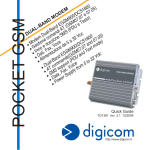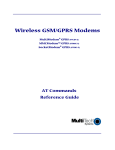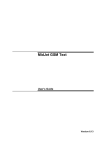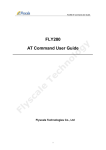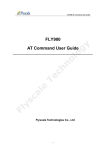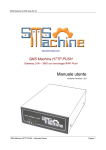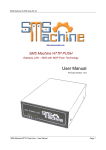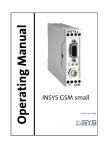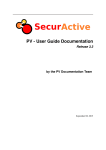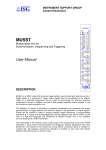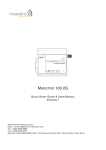Download Digicom Pocket GSM
Transcript
POCKET GSM 0 .11 V nd EM 2a 3 D . 0 80 V MO S1 Kbps e D C d 6 D N . A 00/ to 9 xt mo B 9 p M u Te S AL EG ssion and t d DU i an sm DU or al-B Tran port P supp u D ta up Fax le Da S s and adab SM ice pgr Vo ash U Fl User’s Guide rev. 3.1 12/2004 http://www.digicom.it PocketGSM Index INDEX PREFACE ENVIRONMENTAL CONDITIONS CLEANING THE TERMINAL VIBRATIONS OR DROPPING DECLARATION CE OF CONFORMITY 1. INTRODUCTION 1.1. TECHNICAL FEATURES 1.2. WARNINGS 2. INSTALLATION 2.1. PIN-OUT CONNECTOR 2.2. SIM CARD 2.3. CONNECTION TO THE EXTERNAL ANTENNA 2.4. POWER SUPPLY 2.5. LED INDICATORS 2.6. CONNECTOR FOR THE VOICE MANAGEMENT 3. FUNCTIONAL EXAMPLES 4. AT COMMANDS 4.1. COMMANDS NOTES 4.2. AT COMMANDS DESCRIPTION 4.2.1. GENERAL COMMANDS 4.2.2. 07.07 GSM COMMANDS 4.2.3. PHONEBOOK COMMANDS 4.2.4. VOICE COMMANDS 4.2.5. SMS CONTROL COMMANDS (GSM 07.05) 4.2.6. GPIO COMMANDS (GENERAL PURPOSE INPUT OUTPUT) 4.2.7. GPRS COMMANDS (GSM 07.07) APPENDIX A I II II II II II 1.1 1.1 1.1 2.1 2.1 2.2 2.2 2.4 2.5 2.6 3.1 4.1 4.1 4.2 4.2 4.11 4.18 4.20 4.24 4.30 4.37 A.1 PocketGSM Preface PREFACE All rights reserved; no part of this publication may be reproduced, stored in a retrieval system, or transmitted in any form or by any means, electronic, otherwise, without the prior written permission of Digicom S.p.A. The following installation rules should be respected in order to have the best working order of the equipment and for the user’s safety. ENVIRONMENTAL CONDITIONS Enviromental temperature Relative humidity from -20 to +55°C from 20 to 80% n.c. Rapid changes of temperature or humidity should be avoided. This equipment, including cables, should be installed in an area free from: Dust, humidity, heat from direct sun light. Objects which irradiate heat. These could cause damage to the container or other problems. Objects which produce a strong electtromagnetic field (loudspeakers, etc.) Liquids or chemical corrosive substances. CLEANING THE TERMINAL Use a clean and soft cloth. Wet the cloth with water or natural detergent if it is necessary to remove any stains. Never use chemical products such as petrol or solvents. VIBRATIONS OR DROPPING Caution against vibrations and dropping. DECLARATION OF CONFORMITY We, Digicom S.p.A. registered office at: via Volta 39 - 21010 Cardano al Campo (Varese - Italy) declare under our sole responsability that the product: Name: POCKET GSM Type: Modem Dual-Band GSM 900/1800MHz satisfies the basic requirement of the below indicated Directive: 1999/5/CE of March 9 1999, R&TTE as having been designed in conformity with the requirements of following Reference Standards: EN 60950 EN 301 489-1 EN 301 489-7 EN 301-419-1 EN 301-511 II PocketGSM 1. Introduction INTRODUCTION Congratulation on choosing digicom PocketGSM. Pocket GSM is a GSM Dual-Band modem (EGSM900/DCS1800), perfect for DATA, SMS, FAX and VOICE applications. It has been designed to operate on any digital GSM network both directly and in roaming. PocketGSM is compliant with GSM Class 4 (900Mhz) and Class 1 (1800 Mhz). The dual band functionality depends on the network. Please refer to GSM provider for the availability of the service. 1.1. TECHNICAL FEATURES Power Supply Power Supply: Temperature Operating: Storage: Connectors Power Supply & I/O: Data interface: Antenna: Audio: SIM: Size Size: Weight: from 5 to 32 Vdc from -20°C to +55°C from -20°C to +70°C Mini-Fit™ 12 pin (Molex 556912A1) 9 pin RS232 (V24/V28) SMA female RJ6 female (telephone handset) Plug-In 3V 87x75x25mm about 130gr 1.2. WARNINGS Satefy Read carefully these instructions and notes before powering PocketGSM. For each situation please follow the specific instructions. 1.1 PocketGSM Introduction PocketGSM is a low power radio transmitter and receiver. When it is ON, it sends receives radio frequency (RF) signals. PocketGSM produces magnetic fields. Do not place it next to magnetic support such as floppy disks, tapes, et. . Operating your modem close to other electrical equipment such as television, phone, radios and personal computer, may cause interference. Interference PocketGSM, like all wireless devices, is subject to interferences that may reduce its performances. Road Safety Do not use PocketGSM while driving. In case of use on cars, it is necessary to check that electronic equipment is shielded against RF signal. Do not place PocketGSM over the air bag or in the air bag deployment area. Aircraft Safety Switch off PocketGSM in aircraft by disconnecting the Power cable. Using GSM devices on aircraft is illegal. Hospital Safety Do not use PocketGSM near health equipment, especially pacemaker and hearing aids, to avoid potential interferences. PocketGSM is a not mobile phone, do not use it in direct contact with the human body. Switch it off in hospitals, and medical center. Hospitals or health care facilities may be using equipment that could be sensitive to external RF energy. Explosive Materials Do not use PocketGSM in refuelling points, near fuel or chemicals. Do not use the PocketGSM where blasting is in progress. Observe restrictions, and follow any regulation or instruction. Instructions for use Do not use PocketGSM in direct contact with the human body, do not touch the antenna if not necessary when the phone is in use. Use approved accessories and batteries only. Do not connect incompatible products. 1.2 PocketGSM 2. Installation INSTALLATION The GSM modem installation must be carried out between a range of temperature indicated in the manual. Attention: the power supply voltage must not exceed the indicated maximum value as this may cause a damage of the product. 2.1. PIN-OUT CONNECTOR Connect the serial port of your device to PocketGSM through a 9 pin RS232 right standard connector . This table describes the position of the signals on Pocket GSM connector: 9 pin female connector (DCE) 5 9 1 6 Pin 1 2 3 4 5 6 7 8 9 Description Data Carrier Detect Receive Data Transmitted Data Data Terminal Ready Signal Ground Data Set Ready Request To Send Clear To Send Ring Indicator Initials DCD RD TD DTR GND DSR RTS CTS RI In case your application supports TD and RD (transmission and reception)signals only, it is possible to connect it to the Pocket GSM. In this case it is important to configure PocketGSM to ignore the not present criteria. [ For further information about commands, see the chapters “Functional Examples” and “AT Commands”; you’ll find the “AT Commands” chapter in the user’s manual present on Digicom website ] The modem can receive AT commands at the speeds between 300 and 115200 bit/s. 2.1 PocketGSM Installation 2.2. SIM CARD Plug-in SIM are supported by PocketGSM. To prevent damaging or losing information avoid touching the sim gold area. Attention: Check with your GSM provider if your SIM is enable for data and fax traffic, if not ask him for this service, he will give you other two numbers (one for data calls and the other for fax calls). Insert the SIM Probably the SIM card will be supplied in a card holder compliant with the devices using the full-size SIM. 1. Remove the SIM carefully from the SIM holder. 2. Turn off Pocket GSM, by disconnecting the power connector. 3. Discover the SIM slot and press on the release pin with a finger or a pencil. 4. Insert the SIM card into the holder. Be sure the angled corner is top right. 5. Close the SIM holder and press it up to the end. Do not force the SIM holder and verify the correct position. . 2.3. CONNECTION TO THE EXTERNAL ANTENNA To connect the external antenna go on as follows: 1. Turn off your Pocket GSM by disconnecting the power connector. 2. Connect the SMA male connector to the external antenna of Pocket GSM, screwing it clockwise. 3. Place the antenna and check there is a good quality signal. 2.2 PocketGSM Installation You can check the signal: Using a cellular phone Insert the SIM of the PocketGSM in a cellular phone and check the quality of the signal. Through the Led STATUS Power on the modem and verify the STATUS Led. If it is red blinking, it means the modem is recognized by the GSM network. In this way you can check the signal but not its quality. Attention: even if you see the STATUS Led blinking, it may not be sufficient for data transmission. Through the AT+CSQ command By using this command it is possible to detect a more precise signal. Power on PocketGSM and connect it to a Personal cpmputer, using a serial cable. With a hyperterminal send to the modem the command AT+CSQ. The modem will answer with +CSQ: x,y; where “x” is the signal quality, “y” is the BER (But Error Rate). The value of “x” can be included between 0 to 31; the higher value indicates a better signal. From 0 to 9 : poor From 10 to 15 : good From 16 to 31 : excellent 99 = Unknown or uncalculable BER values higher than 2 may compromise the good operation of the device. In this case place the antenna in a better position. [ For further information about commands, see the chapters “Functional Examples” and “AT Commands”; you’ll find the “AT Commands” chapter in the user’s manual present on Digicom website ] Attention: for better performances of the supplied stilo antenna, we suggest to position it upwards. Try to fix Pocket GSM and its antenna at least one meter from the floor. In case you use a different antenna, do not fix it directly to the mechanics of the product or on metal surfaces. 2.3 PocketGSM Installation 2.4. POWER SUPPLY The inputs, outputs and power supply use a Minifit 12 pin connector: Frontal view PIN 1 2 3 4 5 6 7 8 9 10 11 12 Description OUTPUT 2 (Open Collector) OUTPUT 1 (Open Collector) DIGITAL INPUT 4 DIGITAL INPUT 3 DIGITAL INPUT 2 DIGITAL INPUT 1 N.C. N.C. Power supply from 5 to 32Vdc GND ANALOG INPUT 2 ANALOG INPUT 1 (GPO2) (GPO1) (GPIO5) (GPIO4) (GPIO0) (GPI3) (ADC2) (ADC1) pin 9 : positive [from +5 to +32Vdc] pin 10 : negative [GND] The modem has a special protection in case you accidentally invert the polarity. The modem power supply must be included between 5 and 32 Vdc with ground negative. Attention: the power supply voltage must not exceed the indicated maximum value as this may cause a damage of the product. 2.4 PocketGSM Installation 2.5. LED INDICATORS Through two led indicators you can control the status of Pocket GSM: LED POWER STATUS OFF ON OFF ON STATUS SLOW BLINKING FAST BLINKING DESCRIPTION No power supply Power supply on No power supply PocketGSM is in one of the following status: - network search mode; - SIM card not present; - PIN not inserted; - emergency mode. PocketGSM detected by the GSM network PocketGSM connected to another device PocketGSM is ready to work only after it has been registered by the GSM network and with a good quality signal. To verify that PocketGSM is ready for calls and SMS, follow these commands: COMMAND AT+CPIN? AT+CREG? AT+COPS? AT+CSQ DESCRIPTION Verifies the presence of the SIM and the PIN code Verifies the registration to the GSM network Verifies the current GSM operator Verifies the quality of GSM signal [ For further information about commands, see the chapters “Functional Examples” and “AT Commands”; you’ll find the “AT Commands” chapter in the user’s manual present on Digicom website ] 2.5 PocketGSM Installation 2.6. CONNECTOR FOR THE VOICE MANAGEMENT For the voice functionality, Pocket GSM is equipped with a double ended audio interface on RJ6 female connector with the same Pin-out of a standard telephone handset The interface can be connected both to a handset or to a loud speaking telephone. VOICE connector Pin-Out (RJ6) 4 3 2 1 Microphone ( + ) 2 Speaker ( + ) 3 Speaker ( - ) 4 Microphone ( - ) 1 The modem includes AC coupling and biasing for electret microphone. Suggested characteristics for the microphone Polarizzazione : 2V – 0.5mA Impedance: 2KΩ Sensitivity : from –40dBm to –50dBm SNR (Signal to Noise Ratio) : > 50dBm Suggested characteristics for the speaker Type : 10mW, electro-magnetic Impedance : from 32 to 150 Ω Suggest configuration AT+SPEAKER=0 AT+ECHO=0 AT+SIDET=1,3 [ For further information see the chapter “AT Commands” present in the user’s manual on Digicom website ] 2.6 PocketGSM 3. Functional Examples FUNCTIONAL EXAMPLES Pocket GSM can be programmed through a set of AT commands for the execution of all its functionalities. If you are using a PocketGSM/GPRS, information for the GPRS functionality are present in “AT Commands” chapter. It is present in the user’s manual on Digicom web site. Here the description of some applications. For the complete AT command set, see the chapter “AT Commands”. Attention: In the factory configuration the AT commands are managed at 9600bit/s only (the PocketGSM/ GPRS at 115200bit/s only). Before going on with your settings, you must set your terminal emulator (e.g. HyperTerminal) or your application as follows: 9600,8,N,1 (with PocketGSM/GPRS: 115200,8,N,1) then you can modify the interface speed with the values included between 300 and 115200bit/s with the command AT+IPR. [ For further information see the chapter “AT Commands” present in the user’s manual on Digicom website ] A) PIN management B) PocketGSM ready to work C) Serial cable not completed D) Data transfer E) SMS Management (Text mode) 3.1 PocketGSM Functional Examples A) PIN MANAGEMENT Due to security reasons, usually SIM cards require the insertion of PIN code. With Pocket GSM you can insert the PIN code through the AT+CPIN command. If your application has other security systems, you can disable the PIN request using a mobile phone. Examples: Command: Answer: Answer: Answer: Answer: Answer: AT+CPIN? ERROR +CPIN: READY +CPIN: SIM PIN +CPIN: SIM PUK +CPIN: SIM PIN2 (Verify the SIM and the PIN status) (SIM card reading failed) (PIN code present: SIM ready) (PIN code insertion is required) (PUK code insertion is required) (PIN2 code insertion is required) In case the PIN code is not present, it must be inserted before using the SIM card: Command: AT+CPIN=4321 (PIN insertion) Answer: OK (PIN code right) Answer: ERROR (PIN code wrong) Attention: remember that if the PIN code is wrongly inserted for three times, the SIM card will block. To unblock it you must insert the PUK code. [ For further information see the chapter “AT Commands” present in the user’s manual on Digicom website ] 3.2 PocketGSM Functional Examples B) POCKET GSM READY TO WORK PocketGSM can work only after it has been detected by the network and with a good GSM signal. To verify PocketGSM is ready to manage calls and SMS, follow these commands: Command: Answer: AT+CPIN? +CPIN: READY Command: Answer: AT+CREG? +CREG: 0,1 OK (GSM modem is registered by the network) Command: Answer: AT+COPS? +COPS: 0,2,22288 OK (PocketGSM is registered at operator 22288) Command: Answer: AT+CSQ +CSQ: 15,0 OK (GSM signal: good) (SIM is ready) The CSQ value can be included between 0 and 31, where 0 = –113dBm and 31 = –51dBm. Every unit corresponds to 2 dBm. From 0 to 9 = not sufficient From 10 to 15 = good From 16 to 31 = excellent [ For further information see the chapter “AT Commands” present in the user’s manual on Digicom website ] 3.3 PocketGSM Functional Examples C) SERIAL CABLE NOT COMPLETED In case your application (eg. PLC) supports only TD and RD signals (Trasmission and Reception), it is however possible to connect it to the PocketGSM. In this case you will use a non-completed serial cable; for this reason it is important to configure PocketGSM so that it ignores the serial criteria not present. Usually PocketGSM, during the communication phase, checks the following criteria: 108 (Data Terminal Ready) and 105 (Request To Send): to disable them use the commands AT&D and AT+IFC. Examples: Command: AT&D0 Command: AT&D2 Answer: OK Command: Command: Answer: (Criterion 108 ignored) (Criterion 108 managed as per specification) AT+IFC=0,0 (Criterion 105 ignored: flow control OFF) AT+IFC=2,2 (Criterion 105 managed as per specification: flow control ON) OK D) DATA TRANSFER PocketGSM can call and be called by analog (PSTN), digital (ISDN) and GSM devices. Usually DATA connections with analog modems are at 9600bit/s (V.32 protocol); ISDN connections use V.110 protocol with speed at 9600bit/s. The data transfer with another GSM device is carried out using V.32 or V.110 protocols. DATA Calls Using the ATD command it is possible to make a call. For example, to call the number 0123456789 you must send to the modem the command ATD0123456789<Enter>. Depending on the AT+CBST command setting it is possible to program PocketGSM for analog, digital or GSM calls: AT+CBST=0,0,1 connection with analog or GSM modems in multistandard (V.32) AT+CBST=7,0,1 connection with analog or GSM modems only in V.32 at 9600bit/s AT+CBST=71,0,1 connection with digital or GSM modem only in V.110 at 9600bit/s 3.4 PocketGSM Functional Examples Attention: check with your telephone operator if your SIM is enabled for DATA and eventually for FAX. In fact most SIMs are enabled for Voice(call and reception) while for DATA and FAX only the call is enabled. To enable the reception of DATA and FAX traffic it is necessary to ask the telephone operator that will assign two additional numbers (one to receive DATA calls and one to receive FAX calls). Examples: Command: Answer: Command: Answer: AT+CBST=7,0,1 OK ATD0123456789 CONNECT 9600 V.32 call at 9600bit/s Command: Answer: Command: Answer: AT+CBST=71,0,1 OK ATD0123456789 CONNECT 9600 V.110 call at 9600bit/s DATA calls reception Generally in PocketGSM the automatic answer is disabled (S0=0): in this case the modem will answer only after it received the ATA command. In case you want to enable the automatic answer, you must set the S0 register with the number of rings after which to answer (eg. S0=2 automatic answer after two rings). PocketGSM factory configuration has the AT+CBST=0,0,1 setting, in this way it will be able to answer to any call coming from an analog, ISDN or GSM modem. [ For further information see the chapter “AT Commands” present in the user’s manual on Digicom website ] E) SMS MANAGEMENT (TEXT mode) PocketGSM manages the SMS in TEXT and PDU format. Send an SMS (TEXT mode) You find here the necessary commands to send SMS in TEXT mode. 3.5 PocketGSM Functional Examples 1) Reading and Setup of the Services Center To activate the SMS management, you must insert the identifier number of the Services Center for your GSM operator. In the most recent SIM cards, the identifier is already present in memory: to verify you can use a mobile phone or, with Pocket GSM, you can act as follows: Command: Answer: AT+CSCA? +CSCA: “+393205858500”,145 OK (reading of Services Center) (Services Center present) If the Services Center number is not present, ask the telephone operator, then insert the identifier as follows: Command: Answer: Command: Answer: AT+CSCA=”+393359609600” OK AT+CSAS OK (eg. TIM Services Center) (Save the number of Services Center) Attention: the above mentioned numbers (Services Centers) could be modified by the telephone operator. In case of error after you send the SMS, check the identifier of the Services Center with your Telephone Operator. 2) Define the mode Command: AT+CMGF=1 Answer: OK Command: Answer: AT&W OK (TEXT mode) (Save the configuration) 3) Send a message: Command: AT+CMGS=”+393217654321”<enter> Answer: > 3.6 PocketGSM Text: Answer: Functional Examples First SMS message with Pocket GSM<ctrl z> +CMGS: <sms index> OK After you digit yuor message, press <ctrl z> (Hex =1A). In this example the message “First SMS message with Pocket GSM” is sent to number +393217654321. Attention In case of error after you send the SMS, check the identifier of the Services Center with your Telephone Operator. Read the SMS (TEXT mode) The factory configuration of PocketGSM detects the coming of a new SMS. When an SMS arrives, PocketGSM send to the DTE (eg. PC) the following message: +CMTI: “SM”,2 (2 indicates the memory location of the SIM card where the SMS has been stored). To read the message use the AT+CMGR command: Command: Answer: AT+CMGR=2 +CMGL: 2,"REC UNREAD","+393217654321",,"01/01/75,12:05:46+04" Second SMS message with PocketGSM To display all the messages present in the SIM memory: Command: Answer: AT+CMGL=”ALL” +CMGL: 1,"REC READ","+393217654321",,"01/01/75,12:05:46+04" First SMS message with Pocket +CMGL: 2,"REC UNREAD","+393217654321",,"01/01/75,12:06:26+04" Second SMS message with PocketGSM OK 3.7 PocketGSM Functional Examples Through the AT+CNMI command it is possible to program the PocketGSM so as it sends immediately the received message to the DTE (eg. PC): Command: Answer: AT+CNMI=2,2 OK With this configuration PocketGSM sends immediately the message to the DTE, when it receives it from the network: +CMT: "+393217654321",,"01/01/75,12:06:14+00" First SMS message with Pocket GSM Cancel the SMS For example, to cancel the second message: Command: Answer: AT+CMGD=2 OK [ For further information see the chapter “AT Commands” present in the user’s manual on Digicom website ] 3.8 PocketGSM 4. AT Commands AT COMMANDS PocketGSM supports a complete AT commands set to configure and test the modem and all its functionalities. These commands are based on the following recommandations: ETSI GSM 07.07: Digital cellular telecommunications system (Phase 2); AT command set for GSM Mobile Equipment (ME); ETSI GSM 07.05: Digital cellular telecommunications system (Phase 2); Use of DTEDCE interface for Short Message Service (SMS) and Cell Broadcast Service (CBS); ITU-T Recommandation V.25ter: Serial asynchronous automatic dialling and control. The factory configuration of PocketGSM accepts AT commands only at 9600bit/s (the PocketGSM/GPRS only at 115200bit/s). Before going on you must set your terminal emulator (e.g. HyperTerminal) or your application with these values: Bit per second data bit parity stop bit flow control = 9600 (with PocketGSM/GPRS : 115200) =8 = None =1 = Hardware (RTS/CTS) Use the commands AT+IPR, AT+ICF, AT+IFC to change the modem interface speed and the flow control. 4.1. COMMANDS NOTES Please read these before using PocketGSM: The commands always start with AT; it means Attention, and end with <CR> (Hex=0D) character. The answer messages in extended format (ATV1 command) start and end with <CR><LF> (Hex=0D 0A). If Pocket GSM is programmed to manage numeric answers 4.1 PocketGSM AT Commands (ATV0), then the answer will not have the prefix <CR><LF> and will be ended with the <CR> character. To disable the answer messages use ATQ1 command. If the syntax of the command is wrong, the modem sends the answer ERROR If the syntax of the command is correct but some incorrect parameters are used, the strings +CME ERROR: <Err> or +CMS ERROR: <SMSErr> are sent with different error codes. If the command has been successfully executed, the answer will be OK. (In some cases, such as AT+CPIN? the modem will return the information requested without OK). [In the “Functional Examples”, and in the “AT commands description”, the characters <CR> and <CR><LF> have been intentionally omitted.] 4.2. AT COMMANDS DESCRIPTION 4.2.1. GENERAL COMMANDS ATA Answer an incoming call When the modem receives a call, it sets the Ring Indicator signal and sends to the DTE (e.g. PC) the RING string (or +CRING: <type> if AT+CRC=1). If the automatic answer is disabled (ATS0=0), the ATA command enables the answer to an incoming call. Command ATA Possible answers CONNECT OK Action DATA call accepted VOICE call accepted ATD Dial command This command will dial the number entered after the ATD string. When the modem detects the carrier from the GSM base station, it will answer with the message CONNECT: at this point the data transmission starts. For further information on ATD command, see chapter “Functional Examples”. 4.2 PocketGSM Command ATD<str> <str> Numbers 0...9 + ; L >”text” >mem<idx> >n AT Commands Possible answers CONNECT OK BUSY NO ANSWER NO CARRIER Action DATA / FAX connection is established VOICE connection is established Remote device busy No answer from the called number Failed or refused call Description Examples National call ATD0123456789 International call ATD+987654321 At the end of the number for the VOICE calls ATD0123456789; Redial the last called telephone number ATDL Call to the number in the phonebook associated with the “text” indentifier (by AT+CPBS command) ATD>”Digicom” Call to the number contained in mem position n ATD>SM2 Call to the number stored in the position n of the current phonebook; it can be selected with the AT+CPBS command ATD>1 ATE Echo command When the modem receives a command, it executes the echo of the received characters. With this command it is possible to enable and disable the echo. Command ATE0 ATE1 Default: ATE1 Possible answers OK OK Action Echo disabled Echo enabled ATH Hang up When the modem is on-line after the escape sequence “+++”, this command forces the modem to disconnect. Command Possible answers Action ATH OK The modem disconnects 4.3 PocketGSM AT Commands ATO Back to On-Line mode If you have to interrupt the data flow temporarily to verify the modem status or some registers without disconnecting, you can use the “+++” escape sequence. Then send the AT0 command to return to data mode. Command ATO Possible answers CONNECT Action Back to On-Line mode ATQ Answer messages This command is used to enable and disable the modem answers. Command ATQ0 ATQ1 Default: ATQ0 Possible answers OK OK Action Answer messages enabled Answer messages disabled ATS0 Auto answer The S0 register allows to disable (ATS0=0) or to enable the modem autoanswer when arriving an incoming call. Command ATS0=<n> ATS0? Default: ATS0=0 Possible answers OK / ERROR OK Action Auto answer after n rings Reading of S0 register ATV Result code format This command determines the modem response format: verbose code or numeric code. Command ATV0 ATV1 Default: ATV1 Possible answers OK OK Action Result code display as digit Result code display as words 4.4 PocketGSM AT Commands ATZ Load user profile This command will load a user profile previously saved with the AT&W command. Command ATZ Possible answers OK Action Loads the user profile AT%D Automatic dialing with DTR (C108) This command allows to activate a DATA or VOICE autocall to the number stored in the first location of the SIM phonebook; or the automatic sending of an SMS stored in the SIM first location. The number is dialed when DTR passes from OFF to ON status; the short message is sent when DTR passes from OFF to ON status. Command AT%D0 AT%D1 AT%D1; AT%D2 Default: AT%D0 Possible answers OK OK OK OK Action Function disabled Enables automatic dialing (DATA) Enables automatic dialing (VOICE) Enables automatic sending of the SMS AT&C Data Carrier Detect (C109) This command defines the management of the DCD (C109) on the modem serial port. If controlled (AT&C1), the DCD ON indicates the connection with a remote device. If forced (AT&C0) regardless of the status (connected/disconnected), the DCD is always ON. Note: Data Carrier Detect can be controlled in DATA and FAX modes only. Command AT&C0 AT&C1 Possible answers OK OK Action Data Carrier Detect always ON Data Carrier Detect is controlled and follows the connection status Default: AT&C1 4.5 PocketGSM AT Commands AT&D Data Terminal Ready (C108) This command defines the management of the DTR (C108) on the modem serial port. The DTR comes from the DTE (e.g. PC) to the modem, for this reason the criterion can be present or absent. If absent, the modem must be configured to ignore the criterion (AT&D0). If present, the modem will accept the call only if the criterion is ON. For further information on AT&D command, see chapter “Functional Examples”. Command AT&D0 AT&D1 Possible answers OK OK AT&D2 OK Action DTR is ignored Modem switches from data to command mode when DTR switches from ON to OFF. When DTR switches from ON to OFF the modem disconnects. Default: AT&D2 AT&F Restore factory settings This command is used to load the factory settings for the command listed in the table. Command AT&F Possible answers OK Commands restored with AT&F Q S0 V +CMGF +CNMI +COPS +ECHO +ILRR +SIDET Action Loads the factory configuration %D +CBST +CR +CRC +SPEAKER +VGR +CLIP +CREG +VGT +CMEE +CSMP AT&S Data Set Ready (C107) This command defines the management of DSR (C107) criterion present on the modem serial port. If controlled (AT&S1), the DSR ON indicates a connection with a remote device. When OFF it indicates the disconnection with the remote modem. If forced (AT&S0), regardless of the status (connected/disconnected), the DSR is always ON. Note: Data Set Ready can be controlled in DATA and FAX modes only. 4.6 PocketGSM Command AT&S0 AT&S1 AT Commands Possible responses OK OK Action Data Set Ready always ON Data Set Ready is controlled and follows the connection status Default: AT&S1 AT&V Command AT&V0 AT&V1 AT&V2 Display configuration Possible answers OK OK OK Action Displays the current configuration Displays the stored configuration Displays the factory configuration AT&W Save current configuration This command saves the active configuration, in the EEPROM. Command AT&W Possible answers OK Action Saves the configuration This commands can be saved with AT&W E Q S0 V &C &D +CLIP +CMEE +CMGF +COPS +CR +CRC +IFC +ILRR +IPR +SIDET +SPEAKER &S +CBST +CREG +ICF +VGR +VGT +++ Escape command By sending the escape sequence, the modem switches from data to command mode. If the escape sequence is followed by the ATH command, the connection will be ended. Note: the escape sequence works only with AT+ICF=3,4 (8N1) or =5,1 (7E1) Command +++ Possible answers OK Action Return to command mode 4.7 PocketGSM AT Commands AT+CGMM Model identification Command AT+CGMM Possible answers MULTIBAND 900E 1800 OK Action Device identification AT+CGMR Modem firmware release Command AT+CGMR Possible answers 432a09gm.2D OK Action Modem firmware release AT+CGSN Product Serial Number (IMEI) Command AT+CGSN Possible answers 012345678901234 Action International Mobile Equipment Identity (IMEI) of the GSM module OK AT+CIMI IMSI (International Mobile Subscriber Identity) This command is used to read and identify the IMSI of the SIM card. Command AT+CIMI Possible answers 222016200858803 OK Action 222 : Mobile Country Code (222 = Italy) 01 : Mobile Network Code (01 = Tim) 6200858803 : Mobile Subscriber Identification Number AT+IPR Fixed DTE rate This command specifies the data rate at which the modem will accept data from the DTE (e.g. PC); the answer messages from the modem will use the same speed. 4.8 PocketGSM AT Commands Command Possible answers AT+IPR=<speed> OK / ERROR AT+IPR? +IPR: 9600 AT+IPR=? +IPR: (0,2400,…) Default: AT+IPR=9600 (the PocketGSM/GPRS AT+IPR=115200) <speed> 0 From 300 to 115200 bit/s Action Set the interface rate Shows the current speed Shows the available speeds Description Autobaud enabled: the modem automatically detects the speed, monitoring the received AT command. Interface speed set at one of the following values: 300, 600, 1200, 2400, 4800, 9600, 19200, 38400, 57600, 115200 bit/s. AT+ICF Data format This command allows to select the data synchronous format, the modem will use to accept data from the DTE (e.g. PC); the modem answer messages will use the same format. Note: a data format different from 8N1 ( AT+ICF=3,4) disables the autobaud (AT+IPR=0) if active. If the data format is set at 8N1, the autobaud is automatically enabled. Comando AT+ICF=<format>,<parity> AT+ICF? AT+ICF=? Default: AT+ICF=3,4 Possibili risposte OK / ERROR +ICF: 5,1 +ICF: (1-6), (0-4) <format> 1 2 3 4 5 6 Data Format Data: 8bit; Data: 8bit; Data: 8bit; Data: 7bit; Data: 7bit; Data: 7bit; Azione Set data format Shows the current settings Shows the available settings Parity: 0bit (None); Parity: 1bit; Parity: 0bit (None); Parity: 0bit (None); Parity: 1bit; Parity: 0bit (None); 4.9 Stop: 2bit Stop: 1bit Stop: 1bit Stop: 2bit Stop: 1bit Stop: 1bit PocketGSM AT Commands <parity> 0 1 2 3 4 Examples AT+ICF=3,4 AT+ICF=5,0 AT+ICF=5,1 Parity Format Odd Even Mark Space None Data: 8bit; Data: 7bit; Data: 7bit; Parity: None; Parity: Odd; Parity: Even; Stop: 1bit Stop: 1bit Stop: 1bit AT+IFC Flow control This command is used to set the flow control to be used. For further information on the AT+IFC command, see the chapter “Functional Examples”. Command AT+IFC=0,0 AT+IFC=2,2 AT+IFC? AT+IFC=? Default: AT+IFC=2,2 Possible answers OK OK +IFC: 2,2 +IFC: (0,2), (0,2) Action Flow control disabled Enables the Hardware flow control (RTS/CTS) Shows the current flow control Shows the available values AT+ILRR Interface speed report This command gives a report for the serial port speed, before the connection message. Command AT+ILRR=0 AT+ILRR=1 AT+ILRR? AT+ILRR=? Default: AT+ILRR=0 Possible answers OK OK +ILRR: 0 +ILRR: (0,1) 4.10 Action Report disabled Report enabled Shows the current settings Shows the available settings PocketGSM 4.2.2. AT Commands 07.07 GSM COMMANDS AT+CBST Line Speed Setting This command is used to select the line speed and the protocol for the DATA calls. If Multistandard is selected: when transmitting, the modem sets with the maximum speed available on the GSM network (for Italy V.32 9600 bit/s) when receiving the modem recognizes the speed and the protocol suggested from the remote device. For further information on AT+CBST command, see the chapter “Functional Examples”. Command Possible answers AT+CBST=<speed>,<mode>,<ce> OK / ERROR AT+CBST? +CBST: 0,0,1 AT+CBST=? +CBST: (0-7…), (0),… Default: AT+CBST=0,0,1 <speed> 0 1 2 4 6 7 66 68 70 71 <mode> <ce> 0 1 0 1 0 1 0 1 0 1 0 1 0 1 0 1 0 1 0 1 Description Multistandard V.21 300 bit/s V.22 1200 bit/s V.22 bis 2400 bit/s V.32 4800 bit/s V.32 9600 bit/s V.110 1200 bit/s V.110 2400 bit/s V.110 4800 bit/s V.110 9600 bit/s 4.11 Action Sets the speed and the protocol Shows the current settings Shows the available settings No Transparent No Transparent No Transparent No Transparent No Transparent No Transparent No Transparent No Transparent No Transparent PocketGSM AT Commands AT+CEER Extended error report This command gives a report with the cause of the last disconnection. (See Appendix A for the error codes). Command AT+CEER Possible answers +CEER: Error <err> OK Action Cause of last disconnection AT+CFUN Modem Restart The AT+CFUN=1 command is used for a software reset of the modem; this means also a new registration to the GSM network. Before carrying out a reset, we suggest to save the current configuration (AT&W). The AT+CFUN=0 or AT+CPOF commands are used to switch the modem in Stand-by mode: during this phase the modem is disconnected from the GSM network. To exit from the Stand-by mode use the AT+CFUN=1 command. Command Possible answers AT+CFUN=0 (o AT+CPOF) OK AT+CFUN=1 OK Action Modem in Stand-by Modem restart AT+CLIP Calling Line Identification (CLI) When receiving a call, this command allows to identify the calling number. With the command AT+CLIP? It is possible to obtain the status of the “CLIP Service” in the network. The caller ID is displayed after any RING message. Command AT+CLIP=0 AT+CLIP=1 AT+CLIP? Possible answers OK OK +CLIP: 0,<n> AT+CLIP=? Default: AT+CLIP=0 +CLIP: (0,1) 4.12 Action CLI displaying is disabled CLI displaying id enabled Shows the current settings and the CLIP Service state Shows the available settings PocketGSM <n> 0 1 2 AT Commands CLIP Service status in the network (reading only) CLIP Service not available CLIP Service available Service Status: Unknown (no network…) AT+CLIR Calling Line Identification restriction (CLI) This command allows to hide the Calling Line Identification to the remote device. Note: Independently from the setting of AT+CLIR, it is possible to add an “i” small letter at the end of the calling string to present the CLI to the remote user (e.g. ATD0123456789i); or the letter “I” capital letter to hide the CLI (e.g. ADT0123456789I). Command AT+CLIR=0 Possible answers OK AT+CLIR=1 AT+CLIR=2 AT+CLIR? OK OK +CLIR: 0,<n> AT+CLIR=? Default: AT+CLIR=0 +CLIR: (0-2) <n> 0 1 2 3 4 Action CLI presentation depends on the CLIR Sevice status. CLI is not displayed CLI is displayed Shows the current settings and CLIR Service status Shows the available settings CLIR Service status in the network (reading only) CLIR Service not available CLIR Service available Service Status: Unknown (no network…) CLIR Service temporary suspended CLIR Service temporary available AT+CMEE Report Mobile Equipment errors This command enables the report +CME ERROR: <err> and +CMS ERROR <SMSerr> with the indication of the error code, instead of a generic answer. (See Appendix A for error codes). 4.13 PocketGSM AT Commands Command AT+CMEE=0 AT+CMEE=1 AT+CMEE? Default: AT+CMEE=0 Possible answers OK OK +CMEE: 0 Action Report disabled Report enabled Shows the current settings AT+COPS Operator selection PocketGSM can automatically detect the GSM operator both directly and in roaming. With this command you can check the current provider. Moreover, in extreme cases it is possible to force the registration to a specific provider: in this case check the registration status with the command AT+CREG. With the command AT+COPS=? it is possible to verify the situation of the operators: 0 unknown operator; 1 operator is available; 2 current operator; 3 the operator is forbidden and cannot be selected. For further information on AT+COPS command, see the chapter “Functional Examples”. Command AT+COPS=<mode>, <format>,<oper> AT+COPS? AT+COPS=? Default: AT+COPS=0,2 <mode> 0 1 4 <format> 0 1 2 <oper> Possible answers OK / ERROR Action Selects the operator +COPS: 0,2,22201 +COPS: (2,"I TIM”,”TIM”,”22201”)… Shows the current operator Shows the available operators Registration mode Automatic (<oper> is ignored) Manual If manual selection fails, automatic mode is entered Operator format Long alphanumeric format (e.g. I OMNITEL) Short alphanumeric format (e.g. OMNI) Numeric format (e.g. 22210) Operator identifier 4.14 PocketGSM AT Commands AT+CPIN Enter PIN code This command is used to enter the PIN and PUK codes. If the SIM card, used with Pocket GSM, has the PIN code enabled, it will be necessary to insert it each time you turn the modem on, to permit the registration to the GSM network. The PIN and the PUK code management can be carried out with any mobile phone. For further information on the PIN code management, see chapter “Functional Examples”. Attention: If the PIN code is three times wrongly inserted, the SIM card is blocked. To unblock, insert the PUK code and the new PIN code. (e.g. AT+CPIN=12345678,1234). Command AT+CPIN=<pin> AT+CPIN=<puk>,<pin> AT+CPIN? <status> +CPIN: READY +CPIN: SIM PIN +CPIN: SIM PUK +CPIN: SIM PIN2 ERROR Possible answers OK / ERROR OK / ERROR <status> Action PIN code insertion PUK and PIN insertion Shows the SIM status Description PIN code is present: SIM ready PIN is required PUK is required PIN2 is required SIM card reading failed AT+CR Connection report This command enables the report +CR: <type> that identifies the current connection. The report is given before the connection message. Command AT+CR=0 AT+CR=1 AT+CR? Default: AT+CR=0 Possible answers OK OK +CR: 0 4.15 Action Report disabled Report enabled Shows the current settings PocketGSM AT Commands AT+CRC Cellular Result Code This command enables the report +CRING: <type>, instead of the traditional RING message. Command AT+CRC=0 AT+CRC=1 AT+CRC? Default: AT+CRC=0 Possible answers OK OK +CRC: 0 Action Report disabled Report enabled Shows current settings AT+CREG GSM Network registration This command enables the automatic report to any change of status during the modem registration to the GSM network. For further information on AT+CREG command, see the chapter “Functional Examples”. Command AT+CREG=<n> AT+CREG? Possible answers OK +CREG: <n>,<stat>,[<lac>,<ci>] AT+CREG=? Default: AT+CREG=0 +CREG: (0-2) <n> 0 1 2 <stat> 0 1 2 3 4 5 Action Report enabled or disabled Shows the current registration status of the GSM modem to the network Shows the available settings Report status Report disabled Report enabled with +CREG: <stat> Report enabled with +CREG: <stat>,<lac>,<ci> Registration status Modem not registered, PocketGSM is not currently searching for a new operator Modem registered with the same operator of the SIM card Modem not registered, PocketGSM is searching for a new operator Registration denied Registered at an unknown network Modem registered in roaming 4.16 PocketGSM <lac> <ci> AT Commands Location Area Code in hexadecimal format (e.g. “00C3” is the same as “195” in decimal) Cell ID in hexadecimal format AT+CSQ GSM Signal Quality This command is used to control the GSM quality signal. For further information on AT+CSQ command, see the chapter “Functional Examples”. Command AT+CSQ Possible answers +CSQ: <rssi>,<ber> OK <rssi> Reception level 0 -113 dBm or less 1 -111 dBm 2…30 -109…-53 dBm 31 -51 dBm or greater 99 unknown or not detectable Note: each unit corresponds to 2 dBm <ber> 0 1 2 3 4 5 6 7 99 bit error rate ber < 0,2% 0,2% < ber < 0,4% 0,4% < ber < 0,8% 0,8% < ber < 1,6% 1,6% < ber < 3,2% 3,2% < ber < 6,4% 6,4% < ber < 12,8% ber > 12,8% unknown or not detectable 4.17 Action Reads the signal power and ber PocketGSM AT Commands 4.2.3. PHONEBOOK COMMANDS AT+CPBS Select Phonebook This command selects the memory to be used for the phonebook. Command AT+CPBS=<”storage”> AT+CPBS? Possible answers OK / ERROR +CPBS: <“storage”>,<used>, <total> Action Select the current phonebook memory and the available memory Default: AT+CPBS=”ME” <”storage”> Phonebook “ME” Modem phonebook (250 memory locations) “SM” SIM phonebook (the number of locations depends on the SIM) “LD” Last 10 dialled numbers “RC” Last 10 received calls <used> Locations used <total> Total locations AT+CPBW Write and cancel a telephone number This command allows to write or to delete a telephone number in the current phonebook. It can be selected with the command AT+CPBS. Command Possible answers AT+CPBW=<index>,<”number”>, OK / ERROR <type>,<”text”> AT+CPBW=<index> OK AT+CPBW=? +CPBW: (lista <index>), <ilength>,(lista <type>), <tlength> 4.18 Action Insert the telephone number Cancel the telephone number Shows the information on the memory of the selected phonebook PocketGSM AT Commands <index> Location where to save the telephone number <”number”> telephone number <type> 145 if <”number”> includes the “+” character in the international prefix 129 if <”number”> does not include the “+” character in the international prefix Note: this parameter can be omitted. <”text”> Mnemonic name of the telephone number <ilength> Max length for <”number”> <tlength> Max length for <”text”> Examples AT+CPBW=1,”+39320xxxxxxx”,,”Ufficio Roma” AT+CPBW=2,”320xxxxxxx”,129,”Ufficio Napoli” AT+CPBW=3,”320xxxxxxx”,,”Casa” AT+CPBW=3 Location 1 inserted Location 2 inserted Location 3 inserted Location 3 cancelled AT+CPBR Read a telephone number This command is used to read a telephone number in the current phonebook and can be selected with the command AT+CPBS. Command AT+CPBR=<idx1>,<idx2> <idx1> e <idx2> AT+CPBR=1 AT+CPBR=1,10 Possible answers +CPBR: <idx1>,<number>,<type>,<text> … <idx2>,<number>,<type>,<text> Location range Read entry 1 Read entries from 1 to 10 4.19 Action Reads the numbers in the phonebook from <idx1> to <idx2> PocketGSM AT Commands AT+CPBF Search for a telephone number (knowing the stored text) This command is used to find a telephone number inside the phonebook, knowing the associated identifier (e.g. starting with D…). Command AT+CPBF=<”text”> Possible answers +CPBF: <idx1>,<number>,<type>,<text> <idx2>,<number>,<type>,<text> Action Displays the telephone numbers with the specified <”text”> identifier AT+CPBP Search for a telephone number (knowing the number) This command is used to find an identifier associated with a telephone number inside the phonebook, knowing the number itself. Command AT+CPBP=<”number”> Possible answers +CPBP: <idx1>,<number>,<type>,<text> Action Displays the identifier associated with the specified <”number”> 4.2.4. VOICE COMMANDS PocketGSM can call another voice device with the ATD<number>; command: e.g.ATD0123456789; When the remote device answers the call, PocketGSM will show the OK message. For the voice functionality, PocketGSM is equipped with a double-ended audio interface on RJ6 female connector with the same Pin-out of a standard telephone handset. The interface can be connected both to a handset and to a loud speaking telephone. In order to improve the quality of the voice it will be necessary to modify some parameters to delete the echo, the noise, etc. In this paragraph you can find the commands necessary to improve the voice quality. To save the configuration use the AT&W command. 4.20 PocketGSM AT Commands AT+SPEAKER Speaker and Microphone selection With a single command, you can set the factory parameters of the commands: AT+VGR, AT+VGT, etc; in this way you can quickly improve the quality of the voice. Note: Act also on AT+VGR, AT+CGT, commands to improve the quality of the voice. If there is noise you could connect an external antenna with extension cable. Command AT+SPEAKER=0 AT+SPEAKER? Default: AT+SPEAKER=0 Possible answers OK +SPEAKER: 0 Action Configuration for “telephone handset” Shows the current settings AT+CMUT Mute Control During a voice connection, this command disables the microphone while the speaker is always active. Command AT+CMUT=0 AT+CMUT=1 AT+CMUT? Default: AT+CMUT=0 Possible answers OK OK +CMUT: 0 Action Microphone enabled Microphone disabled (MUTE) Shows the current settings AT+VTS Send DTMF tones During a voice connection, this command sends the DTMF tones, to allow the surfing in vocal servers. Note: wait always the OK, before sending another tone. Command Possible answers AT+VTS=<DTMF> OK / ERROR <DTMF> DTMF tones 0…9 Numbers from 0 to 9 # # character * Asterisk character A…D A, B, C, D characters 4.21 Action Send the specified DTMF tone PocketGSM AT Commands AT+VTD Length of the DTMF tone This command is used to increase or reduce the length of the DTMF tone, sent with the command AT+VTS. Command AT+VTD=<time> AT+VTD? Default: AT+VTD=1 <time> 1 2 … 10 … Possible answers OK / ERROR +VTD: 1 Action Sets the length of the DTMF tone Shows the current settings DTMF tones 100 milliseconds 200 milliseconds … 1 second … AT+VGR Speaker gain control This command is used to set the receiving level of the speaker. (See Appendix A for the values of the speaker gain). Command AT+VGR=<val> AT+VGR? Possible answers OK / ERROR +VGR: 64 Action Sets the receiving level of the speaker Shows the current settings AT+VGT Microphone gain control This command is used to set the transmission level of the microphone. (See Appendix A for the values of the microphone gain). Command AT+VGT=<val> Possible answers OK / ERROR AT+VGT? +VGT: 64 4.22 Action Sets the transmission level of the microphone Shows the current settings PocketGSM AT Commands AT+ECHO Echo cancellation This command enables the echo cancellation for voice calls in small rooms. It could be necessary to act on the (AT+VGT) and (AT+VGR) commands for a best voice quality. Command Possible answers AT+ECHO=<mode>,<algold> OK / ERROR AT+ECHO? +ECHO: <status>,<algold> Action Sets the echo cancellation Shows the current settings <mode> Mode 0 Echo disabled 1 Echo enabled Note: you can enable/disable the echo cancellation during a call without restarting the modem if you don’t change the Algorithm. <algold> Algorithm 1 Echo cancellation 1 3 Echo cancellation 3 <status> Status 0 Eco disabled 1 Eco enabled for “telephone handset” 2 Eco enabled for “loud speaking telephone” 3 Module reset AT+SIDET SideTone Control This command is used to set the echo level of the voice in the speaker (to have a microphone feedback in the speaker). Command AT+SIDET=0,<val> AT+SIDET=1,<val> AT+SIDET? Possible answers OK / ERROR OK / ERROR +SIDET: 1,1 4.23 Action SideTone disabled SideTone enabled Shows the current settings PocketGSM <val> 0 1 2 3 AT Commands Description 0 db -6db -12db -18db AT+VIP Voice parameters Initialization This command allows to restore the factory settings for the voice parameters from EEPROM. These voice parameters include: AT+SPEAKER; AT+CMUT; AT+VGR; AT+VGT AT+ECHO; AT+SIDET. Command AT+VIP=1 4.2.5. Possible answers OK Action Restores the factory settings SMS CONTROL COMMANDS (GSM 07.05) AT+CMGF Messages format This command is used to define the SMS format (Short Message Service). For further information on AT+CMGF command, see the chapter “Functional Examples”. Command AT+CMGF=0 AT+CMGF=1 AT+CMGF? Possible answers OK OK +CMGF: 1 Action SMS in PDU mode SMS in Text mode Shows the current settings AT+CSCA Service Center Number This command allows to set the Service Center number in the SIM card memory. An error will occur if trying to send an SMS using a wrong number of the Services Center. Verify with your GSM Operator the number of the Service Center. For further information on AT+CSCA command, see the chapter “Functional Examples”. 4.24 PocketGSM AT Commands Command Possible answers AT+CSCA? +CSCA: “Service Center Address” AT+CSCA=“ Service Center OK Address” Action Displays the Service Center number Inserts the Service Center number AT+CSMP Period of Validity for the SMS This command is used to define period of validity of the message in the Services Center. Command AT+CSMP=<fo>,<vp>, <pid>,<dcs> AT+CSMP? Possible answers OK / ERROR Action Sets the period of validity +CSMP: <fo>,<vp>,<pid>,<dcs> Shows the current settings Default: AT+CSMP=1,167 <fo> <vp> “11“ “71“ “167“ “173” “255” <pid> <dcs> Reserved (value is 1, do not modify) Period of validity 1 hour 6 hours 24 hours 1 week Higher Reserved Reserved AT+CSAS Save settings This command allows to save the settings of the following commands: AT+CSCA, AT+CSMP and AT+CNMI. For further information on AT+CSAS command, see the chapter “Functional Examples”. Command AT+CSAS Possible answers OK 4.25 Action Save the current settings PocketGSM AT Commands AT+CRES Restore settings This command restores the setting of the following commands: AT+CSCA, AT+CSMP and AT+CNMI. Command AT+CRES Possible answers OK Action Restore the saved settings AT+CNMI Indication of New incoming message This command displays a report when a new SMS arrives. For further information on AT+CNMI command, see the chapter “Functional Examples”. Command AT+CNMI=<mode>,<mt> AT+CNMI? Default: AT+CNMI=0,1 <mode> 2 0,1,3 <mt> 0 1 2 Possible answers OK / ERROR +CNMI: <mode>,<mt> Action Select the report display mode Shows the current settings Display Mode If the modem is Off-line, the message will be displayed on the DTE in <mt> format. If the modem is On-line, the message will be displayed on the DTE in <mt> format at the end of the connection. Equal to 2 Report format No report Report with format: +CMTI: <mem>,<index> Report with format: +CMT:<oa>,[<alpha>],<scts>[,<tooa>,<fo>,<pid>,<dcs>,<sca>,<tosca>,<lengh>] <data> 4.26 PocketGSM AT Commands Examples 1) AT+CNMI=2,1 Report: +CMTI: "SM",2 Description: The received SMS has been stored in the location 2 of the SIM memory. 2) AT+CNMI=2,2 Report: +CMT: "+393217654321",,"01/01/75,12:06:14+00" First SMS message with PocketGSM Description: the received SMS is displayed directly on the DTE. AT+CMGD Delete messages This command is used to delete the SMS messages stored in the SIM memory. For further information on AT+CMGD command, see the chapter “Functional Examples”. Command Possible answers AT+CMGD=<index>,<deflag> OK / ERROR <index> <deflag> 0 1 2 3 4 Action Cancella i messaggi SMS Memory index Delete method Delete the message in the <index> position. If <deflag> value is omitted, it will be equal at 0. Delete all the received and read messages: “REC READ”. The <index> value is ignored. Delete all the received, read, saved and sent messages: “REC READ” and “STO SENT”. The <index> value is ignored. Delete all the received, read, saved, sent and unsent messages: “REC READ”, “STO SENT” and “STO UNSENT”. The <index> value is ignored. Delete all messages. The <index> value is ignored. 4.27 PocketGSM AT Commands AT+CMGL Messages List This command displays the list of the SMS messages stored in the SIM memory. For further information on AT+CMGL command, see the chapter “Functional Examples”. Command AT+CMGL=<stat> <stat> Possible answers OK / ERROR Action Shows the list of SMS Display method Text mode PDU mode “REC UNREAD” 0 “REC READ” 1 “STO UNSENT” 2 “STO SENT” 3 “ALL” 4 Description Displays all the received unread messages Displays all the received and read messages Displays all the stored unsent messages Displays all the stored sent messages Display all the messages AT+CMGR Display message This command allows to display a specific SMS stored in the SIM memory For further information on AT+CMGR command, see the chapter “Functional Examples”. Command AT+CMGR=<index> Possible answers OK Action Shows the message AT+CMGS Send SMS This command is used to send a SMS message in Text mode. For further information on AT+CMGS command, see the chapter “Functional Examples”. Examples Command:AT+CMGS=”+393217654321”<enter> Answer: > Text: First SMS message with PocketGSM<ctrl z> Answer: +CMGS: <sms index> OK 4.28 PocketGSM AT Commands Compose your message, press <ctrl z> (Hex =1A). To cancel the procedure, press <esc> (Hex = 1B). In this example the message “First SMS message with Pocket GSM” is sent to number +393217654321. AT+CMSS Send a stored SMS This command is used to send a previously stored SMS message in Text format. Check the memory location with the AT+CMGL=”ALL” command. Command AT+CMSS=<index> Possible answers OK Action Sends the SMS message stored in <index> location AT+CMGW Store an SMS This command is used to store an SMS message in text format into the SIM memory. Examples Command:AT+CMGW=”+393217654321”<enter> Answer: > Text: First SMS message with PocketGSM<ctrl z> Answer: +CMGW: <sms index> OK Compose your message, press <ctrl z> (Hex =1A). To cancel the procedure, press <esc> (Hex = 1B). In this example the message “First SMS message with Pocket GSM” is stored. 4.29 PocketGSM AT Commands 4.2.6. GPIO COMMANDS (GENERAL PURPOSE INPUT OUTPUT) Besides the functionalities for the DATA, SMS, FAX and VOICE management, Pocket GSM can also read some inputs contacts and control some output relays. Thanks to this characteristic, you will be able to build a complete application using a single device: you can detect the status change of an input and send an SMS alarm; you can receive a specific SMS and control a output relay. In this paragraph you find the characteristics of the General Purpose Input/Output (GPIO) and the AT commands to control them. MINIFIT CONNECTOR The inputs, the outputs and the power supply are managed through a Minifit connector (12 pin): Frontal view (1) PIN Description 1 OUTPUT 2 [Open Collector] 2 OUTPUT 1 [Open Collector] 3 INPUT DIGITALE 4 4 INPUT DIGITALE 3 5 INPUT DIGITALE 2 6 INPUT DIGITALE 1 7 N.C. 8 N.C. 9 from +5 to +32Vdc 10 GND 11 INPUT ANALOGICO 2 12 INPUT ANALOGICO 1 If you use the complete connector with 12 cables. 4.30 (GPO2) (GPO1) (GPIO5) (GPIO4) (GPIO0) (GPI3) (ADC2) (ADC1) Wire color (1) Yellow Green Blue Light Blue Brown Violet White Grey Red Black Pink Orange PocketGSM AT Commands Power on PocketGSM connecting the cable with the correct polarity: pin 9: positive [from +5 to +32Vdc] pin 10: negative [GND] The modem has a special protection in case you accidentally invert the polarity. CHARACTERISTICS OF GPIO CONTACTS PocketGSM supports: 4 digital inputs (two logical states: ON/OFF); 2 analog inputs; 2 output open-collector. Digital Inputs Two status are supported for each input: open or closed to ground. It is necessary connect only a free contact (without voltage) between the input pin (pin 6, 5, 4, 3) and the ground pin (pin 10). DIGITAL INPUT CHARACTERISTICS Permitted status: Input open Input closed to ground (GND) Analog Inputs Two Analog to Digital Converter are available on the PocketGSM. These converters have a 10 bit resolution, ranging from 0 to 28 Vdc. ANALOG INPUT CHARACTERISTICS Resolution 10bit Input signal range From 0 to 28Vdc To read the value, use AT+ADC command. Send AT+ADC=1 command and read the value with AT+ADC? command. 4.31 PocketGSM AT Commands Command AT+ADC? Possible answers +ADC: <ADC3>,<ADC2>,<ADC1> Action Shows the current value Ignore the first value <ADC3>; read only ADC1 and ADC2. This command gets the (DC level * 1024) of ADC1 and ADC2. Output The two outputs of PocketGSM (old and new version), manage the devices that can be activated and deactivated through a switch. (e.g. Lamp, Sound, Logic Port, etc...). To connect your devices, check the Transistor characteristics: max collector-emitter voltage (Vce) and collector current (Ic): Vce (max): Ic (max): 45V 500mA 4.32 PocketGSM AT Commands Connection Examples If you want to manage a simple led (1,5V – 20mA), with a 12V power supply, you must add a pull-up resistor (470Ω) to limit the current. If you want to manage a lamp with 230V power supply, you can connect an external rele and a diode (1N4007 or 1N4148) to protect the transistor inside the PocketGSM Note: if you use a cable to connect the rele, connect the diode close to the pin1 or pin2 of the PocketGSM to protect the transistor inside the PocketGSM. 4.33 PocketGSM AT Commands AT+WIOM Input/Output Configuration This command allows to configure the 6 contacts I/O. If they are configures as Output, it is possible to establish the default status (Reset or Set) at every restart. Command Possible answers AT+WIOM=<IODir>,<IOVal> OK / ERROR AT+WIOM? +WIOM: <IODir>,<IOVal> <IODir> bit 0 bit 1 bit 2 bit 3 bit 4 bit 5 bit 6-7 <IOVal> 0 2 4 6 Action GPIO configured Shows the current settings GPIO direction (Input or Output) (bit mapped register) 0 = GPIO0 configured as Input 1 = GPIO0 configured as Output 1 = GPO1 configured as Output 1 = GPO2 onfigured as Output 0 = GPI3 configured as Input 0 = GPIO4 configured as Input 1 = GPIO4 configured as Output 0 = GPIO5 configured as Input 1 = GPIO5 configured as Output Not used Output default value after reset (bit mapped register) OUTPUT1 Reset OUTPUT2 Reset OUTPUT1 Set OUTPUT2 Reset OUTPUT1 Reset OUTPUT2 Set OUTPUT1 Set OUTPUT2 Set Remember: The Open Collector outputs are usually OPEN. 4.34 PocketGSM AT Commands Possible settings AT+WIOM=6,0 GPIO0 GPO1 GPO2 GPI3 GPIO4 GPIO5 AT+WIOM=6,2 AT+WIOM=6,4 AT+WIOM=6,6 INPUT2 OUTPUT1 OUTPUT2 INPUT1 INPUT3 INPUT4 GPIO0 GPO1 GPO2 GPI3 GPIO4 GPIO5 INPUT2 OUTPUT1 OUTPUT2 INPUT1 INPUT3 INPUT4 GPIO0 GPO1 GPO2 GPI3 GPIO4 GPIO5 INPUT2 OUTPUT1 OUTPUT2 INPUT1 INPUT3 INPUT4 GPIO0 GPO1 GPO2 GPI3 GPIO4 GPIO5 INPUT2 OUTPUT1 OUTPUT2 INPUT1 INPUT3 INPUT4 (initial state: Reset) (initial state: Reset) (initial state: Set) (initial state: Reset) (initial state: Reset) (initial state: Set) (initial state: Set) (initial state: Set) 4.35 PocketGSM AT Commands AT+WIOR Read GPIO value This command reads the current state (Reset or Set) of an Input. It is not possible to read the state of an Output. Trying to read an Output status will cause an ERROR. Command AT+WIOR=<Index> Possible answers +WIOR: <Val> Action Reads the current status <Index> Digital Input index (values: 0, 3, 4, 5) AT+WIOR=3 Reads the Digital Input 1 status AT+WIOR=0 Reads the Digital Input 2 status AT+WIOR=4 Reads the Digital Input 3 status AT+WIOR=5 Reads the Digital Input 4 status <Val> Digital Input state 0 Reset 1 Set AT+WIOW Write GPIO value This command writes the state (Reset o Set) of an Output. It is not possible to write the state of an Input. Trying to write an Input status will cause an ERROR. By default (after a power off/on) the Output contact is set by AT+WIOM command. Command Possible answers AT+WIOW=<Index>,<Val> OK / ERROR <Index> Output index (values 1, 2) AT+WIOW=1,<Val> Writes the Output 1 status AT+WIOW=2, <Val> Writes the Output 2 status <Val> GPIO state 0 Reset 1 Set 4.36 Action Writes the output status PocketGSM 4.2.7. AT Commands GPRS COMMANDS (GSM 07.07) The GPRS functionality is available only in some versions of PocketGSM. If available for the best use of the GPRS function, we suggest to set AT+IPR=0 (autobaud) and to save the configuration with AT&W command. After the driver installation, select in driver properties the interface speed at 115200. GPRS activation Verify with your GSM Operator the GPRS activation. GPRS configuration To configure PocketGSM for GPRS connection, you must send the AT+CGDCONT to se the access profile to the service. Check with the GSM Operator your access profile. AT+CGDCONT=1,”IP”,”APN” You can insert the AT+CGDCONT command in the Additional string in the driver properties or send the command by HyperTerminal and save it with AT&W command. Connection Now you are ready for a Dial-Up connection and a GPRS connection, using the drivers. Verify with your GSM Operator the GPRS parameters (e.g. User ID, password, phone number). For further technical information and for the driver, see the Support area on our web site www.digicom.it, or send a e-mail to [email protected] 4.37 PocketGSM Appendix A A APPENDIX A A1. (+CEER: Error <err>) Report Error Codes <err> 1 3 6 8 16 17 18 19 21 22 26 27 28 29 30 31 34 38 41 42 43 44 47 49 50 55 57 58 Description Unassigned (unallocated) number No route to destination Channel unacceptable Operator determined barring Normal call clearing User busy No user responding User alerting, no answer Call rejected Number changed Non selected user clearing Destination out of order Invalid number format (incomplete number) Facility rejected Response to STATUS ENQUIRY Normal, unspecified No circuit/channel available Network out of order Temporary failure Switching equipment congestion Access information discarded Requested circuit/channel not available Resources unavailable, unspecified Quality of service unavailable Requested facility not subscribed Incoming calls barred with in the CUG Bearer capability not authorized Bearer capability not presently available A.1 PocketGSM 63 65 68 69 70 79 81 87 88 91 95 96 97 98 99 100 101 102 111 127 240 241 252 253 254 255 Appendix A Service or option not available, unspecified Bearer service not implemented ACM equal to or greater than ACMmax Requested facility not implemented Only restricted digital information bearer capability is available Service or option not implemented, unspecified Invalid transaction identifier value User not member of CUG Incompatible destination Invalid transit network selection Semantically incorrect message Invalid mandatory information Message type non-existent or not implemented Message type not compatible with protocol state Information element non-existent or not implemented Conditional IE error Message not compatible with protocol state Recovery on timer expiry Protocol error, unspecified Interworking, unspecified FDN is active and number is not in FDN Call operation not allowed Call barring on outgoing calls Call barring on incoming calls Call impossible Lower layer failure Note: All other values in the range 0 to 31 shall be treated as cause 31 All other values in the range 32 to 47 shall be treated as cause 47 All other values in the range 48 to 63 shall be treated as cause 63 All other values in the range 64 to 79 shall be treated as cause 79 All other values in the range 80 to 95 shall be treated as cause 95 All other values in the range 96 to 111 shall be treated as cause 111 All other values in the range 112 to 127 shall be treated as cause 127 A.2 PocketGSM Appendix A A.2. (+CME ERROR: <error>) Report Error Codes <error> 3 4 5 10 11 12 13 16 20 21 22 24 26 30 32 40 Description Operation not allowed Operation not supported PH-SIM PIN required SIM not inserted SIM PIN required SIM PUK required SIM failure Incorrect password Memory full Invalid index Not found Text string too long Dial string too long No network service Network not allowed – emergency calls only Network personalisation PIN Required (Network lock) A.3 PocketGSM Appendix A A.2.1. (+CMS ERROR: <SMSerror>) Report Error Codes <SMSerror> Da 1 a 127 301 302 303 304 305 310 311 312 313 316 317 318 321 322 330 340 Description Error cause values from the GSM recommendation 04.11 Annex E-2 SMS service of ME reserved +CSMS Operation not allowed All SMS commands Operation not supported All SMS commands Invalid PDU mode parameter Invalid text mode parameter SIM not inserted All SMS commands SIM PIN required All SMS commands PH-SIM PIN required All SMS commands SIM failure All SMS commands SIM PUK required All SMS commands SIM PIN2 required All SMS commands SIM PUK2 required All SMS commands Invalid memory index SIM memory full SC address unknown No +CNMA acknowledgement expected +CNMA A.4 PocketGSM Appendix A A.3. Values of the speaker gain (AT+VGR=<val>) <val> 0 – 15 16 – 31 32 – 47 48 – 63 64 – 79 80 – 95 96 – 111 112 – 127 128 – 143 144 – 159 160 – 175 176 – 191 192 – 207 208 – 223 224 – 239 240 – 255 Speaker gain +6 db +4 db +2 db +0 db -2 db -4 db -6 db -8 db -10 db -12 db -14 db -16 db -18 db -20 db -22 db -24 db A.5 PocketGSM Appendix A A.3.1. Values of the Microphone transmission (AT+VGT=<val>) Values for “telephone handset” <val> Gain 0 – 31 +30 db 32 – 63 +33 db 64 – 95 +36 db 96 – 127 +39 db 128 – 159 +42 db 160 – 191 +45 db 192 – 223 +48 db 224 – 255 +51 db Values for “loud speaking telephone” <val> Gain 0 +0 db 1 +0,5 db 2 +1 db 3 +1,5 db … … 19 9,5 db 20 10 db 21 – 60 30 db 61 30,5 db 62 31 db … … 101 50,5 db 102 – 127 51 db 128 – 243 -6,5 db 244 -6 db 245 -5,5 db 246 -5 db … … 255 -0,5 db A.6 ITALY 21010 Cardano al Campo VA via A. Volta 39

































































